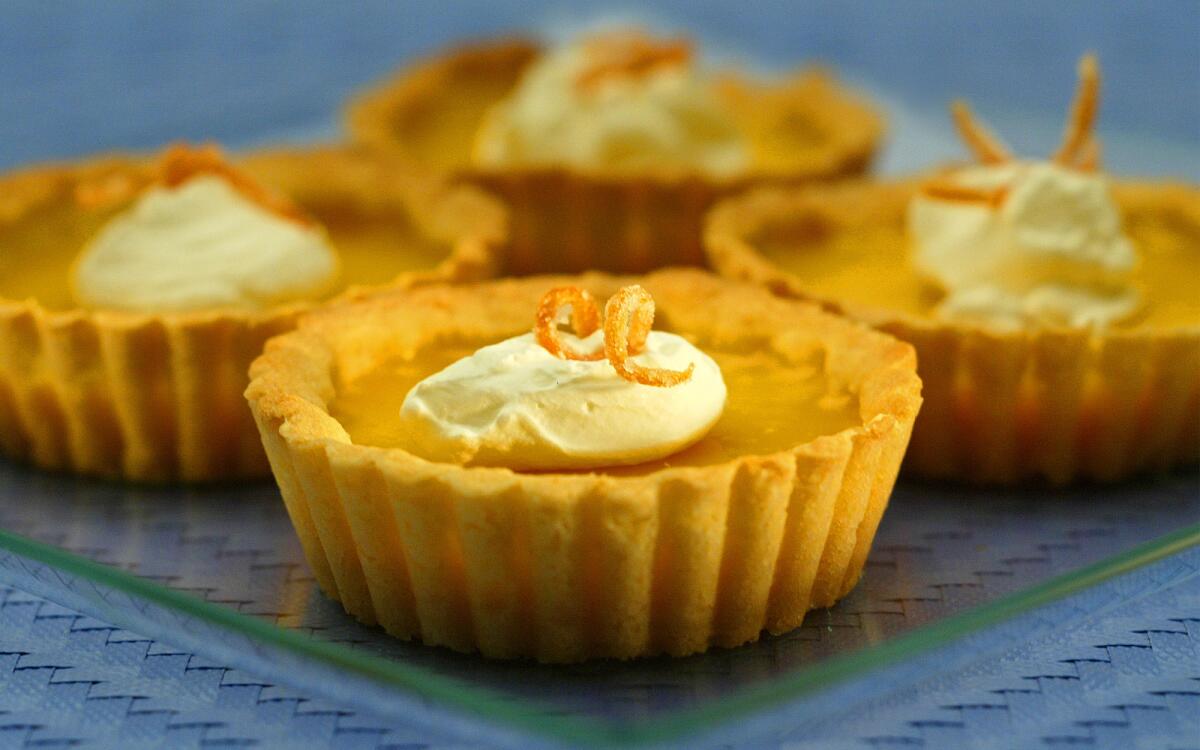Grapefruit curd tartlets

- Share via
Hanging around on trees all about California: grapefruits -- heavy with juice, tartly sweet, beguilingly perfumed. Round and yellow as happy faces or suns, they seem to ripen just as the general populace sinks into its annual round of post-holiday dietary self-chastisement.
Coincidence? Perhaps. But we say run with it.
Look beyond the obvious salvo of half a grapefruit for breakfast attacked with a jagged spoon and you’ll find a marvelous fruit for peeling and eating out of hand. There’s nothing like it for inducing simultaneous feelings of gastronomic piety and delight at recapturing a long-lost pleasure. It’s sensual: the aroma of essential oils as they spurt daintily from the pores of the thick skin, the ripping sound of the tenacious segments being pulled apart, the juice dripping down. And it’s delicious.
But don’t stop there. Cook with grapefruit. Use its juice to flavor sauces. Section and scatter it. Bake with it. Candy its peel. Grapefruit is milder and sweeter than lemon, but it can be used in many of the same ways -- squeezed on grilled fish, made into a brightly flavored curd. And if you’re looking for gorgeous color, red grapefruit offers extra plate appeal.
The notion that red grapefruit is sweeter than white or yellow grapefruit is, however, a myth, according to citrus specialists. (The story grew out of a marketing campaign by Texas growers.) Red grapefruits get their color from lycopene, which has health benefits (it’s an antioxidant) but does not affect flavor.
Sweetness is determined, rather, by the length of time the fruit has been hanging on a tree. A grapefruit picked in December isn’t as sweet as one picked in February, so if you have a tree, just pick fruit as needed.
If not, ask at your farmers market about the different varieties available, all of which have their fans. California reds include the medium-pink Rio Reds from the Coachella Valley and the Star Ruby from the Central Valley (and Texas). Yellow Marsh is a familiar yellow variety and the Duncan, while not usually labeled as such in supermarkets, is a reliable white.
For those who don’t like the tartness of a true grapefruit, Oro Blanco -- the half-grapefruit, half-acidless pummelo -- is sweeter and can be used in salads.
Our salad of jicama strips, thinly sliced snow peas, fresh pea sprouts (available in Asian markets) and red grapefruit sections has an appealing crunch. Its delicately harmonious flavors are pulled together with a faintly sweet dressing of grapefruit juice, tarragon and mint.
The strikingly pink sauce of our baked halibut dish contrasts with the white flesh of the fish for an artful plate -- and it’s easy to make. Before baking, marinate the halibut in grapefruit juice with garlic and thyme. Sauce it with a reduction of grapefruit juice combined with blood orange juice, which deepens the color and softens the flavor. Then whisk in bits of cold butter for silkiness.
A rich crust is a perfect foil for the tangy grapefruit curd filling in our pretty tartlets. Both grapefruit juice and lemon juice are used in the curd to focus the flavor; grapefruit zest enlivens the crust. Garnish them with whipped cream and candied grapefruit peel.
For cooking, select heavy fruit, which indicates juiciness. (If you’re making a batch of candied peel, however, lighter fruit will indicate more peel.) Before juicing, roll a grapefruit under your hand on the countertop to help extract the most juice. Avoid lumpy fruit, which may be over-ripe.
And finally, for those whose resolute January superegos care about such things, here’s a reassuring thought: Grapefruit is low in calories (40 to 60 each), high in vitamins C and A, and an excellent source of fiber. It contains no fat, sodium or cholesterol.
So peel away.
Crust
In the bowl of a food processor, combine the butter and sugar. Pulse until the mixture resembles coarse, pea-sized crumbs.
Add the egg yolk, zest and juice to the bowl and pulse until combined. Add the flour and pulse until the mixture comes together to form a ball. Flatten the dough to one-fourth-inch thickness and wrap in plastic. Freeze for at least 1 or up to 24 hours.
Remove the dough from the freezer and heat the oven to 375 degrees. Allow the dough to sit at room temperature until it is pliable but still very cold. On a well-floured surface, roll the dough to a one-eighth-inch thickness. Lightly spray 6 (4-inch) tart pans with removable bottoms, and cut out 6 (5-inch) circles. Press the circles of dough into the pans and trim the dough to fit.
Line the tart shells with foil and fill with dried beans or pie weights. Bake the crusts until the edges are pale gold, about 15 minutes. Remove the foil and pie weights and return the tart crusts to the oven. Bake until the crusts are golden brown, about 5 to 10 minutes. Cool completely before filling.
Filling
Place the eggs, egg yolks, sugar, zests and juices in a bowl and whisk to combine the ingredients. Transfer the mixture to a double boiler and begin heating at a medium-low temperature. Do not let the mixture become too hot, or the eggs will start to scramble. Stirring frequently with a rubber spatula, cook the mixture until it thickens enough to mound on itself, about 20 to 25 minutes.
Place the butter in a bowl. Strain the egg-grapefruit mixture through a fine-mesh sieve into the same bowl. Stir to melt and incorporate the butter. Pour the filling into the cooled tart crusts. Refrigerate the tarts for at least 3 hours before serving.
At least 20 minutes before serving, bring the tarts out of the refrigerator. Garnish with whipped cream and candied grapefruit peel if desired.
Get our Cooking newsletter.
Your roundup of inspiring recipes and kitchen tricks.
You may occasionally receive promotional content from the Los Angeles Times.















